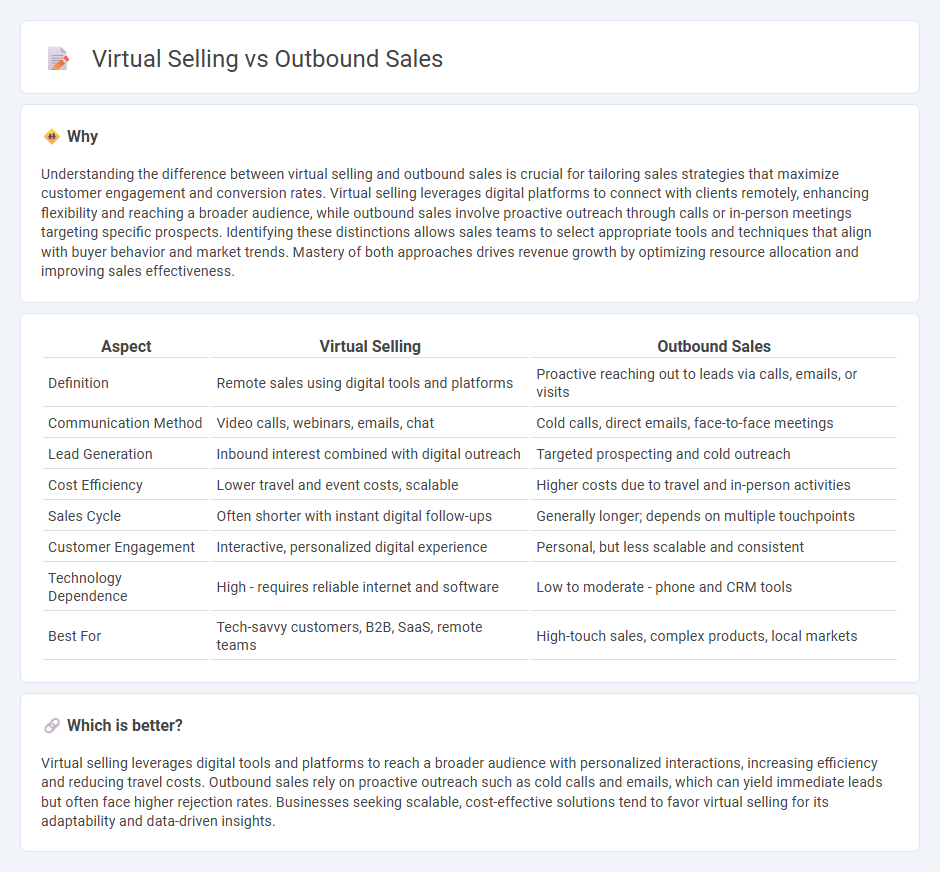
Virtual selling leverages digital platforms to engage prospects remotely, enhancing reach and reducing travel time compared to traditional outbound sales methods that rely on direct cold calling and in-person meetings. This approach integrates video conferencing, CRM tools, and AI-driven analytics to personalize the sales process and improve conversion rates. Explore the latest strategies to optimize both virtual and outbound sales for maximum revenue growth.
Why it is important
Understanding the difference between virtual selling and outbound sales is crucial for tailoring sales strategies that maximize customer engagement and conversion rates. Virtual selling leverages digital platforms to connect with clients remotely, enhancing flexibility and reaching a broader audience, while outbound sales involve proactive outreach through calls or in-person meetings targeting specific prospects. Identifying these distinctions allows sales teams to select appropriate tools and techniques that align with buyer behavior and market trends. Mastery of both approaches drives revenue growth by optimizing resource allocation and improving sales effectiveness.
Comparison Table
| Aspect | Virtual Selling | Outbound Sales |
|---|---|---|
| Definition | Remote sales using digital tools and platforms | Proactive reaching out to leads via calls, emails, or visits |
| Communication Method | Video calls, webinars, emails, chat | Cold calls, direct emails, face-to-face meetings |
| Lead Generation | Inbound interest combined with digital outreach | Targeted prospecting and cold outreach |
| Cost Efficiency | Lower travel and event costs, scalable | Higher costs due to travel and in-person activities |
| Sales Cycle | Often shorter with instant digital follow-ups | Generally longer; depends on multiple touchpoints |
| Customer Engagement | Interactive, personalized digital experience | Personal, but less scalable and consistent |
| Technology Dependence | High - requires reliable internet and software | Low to moderate - phone and CRM tools |
| Best For | Tech-savvy customers, B2B, SaaS, remote teams | High-touch sales, complex products, local markets |
Which is better?
Virtual selling leverages digital tools and platforms to reach a broader audience with personalized interactions, increasing efficiency and reducing travel costs. Outbound sales rely on proactive outreach such as cold calls and emails, which can yield immediate leads but often face higher rejection rates. Businesses seeking scalable, cost-effective solutions tend to favor virtual selling for its adaptability and data-driven insights.
Connection
Virtual selling leverages digital tools and platforms to engage prospects remotely, making outbound sales more efficient and scalable. Outbound sales strategies use targeted outreach methods such as cold calls, emails, and social media to initiate contact, which virtual selling complements by facilitating real-time, personalized interactions online. Integrating virtual selling with outbound sales enhances lead conversion rates by combining proactive prospecting with seamless digital communication.
Key Terms
**Outbound Sales:**
Outbound sales involves proactively reaching out to potential customers through cold calls, emails, and direct messaging to generate leads and close deals. This method relies heavily on targeted prospecting, personalized communication, and a structured follow-up process to build relationships and convert opportunities. Explore the advantages and strategies behind outbound sales to enhance your business growth.
Cold Calling
Cold calling remains a vital component of outbound sales, leveraging direct phone interactions to initiate customer relationships and generate leads. Virtual selling integrates cold calling with digital tools such as video conferencing and CRM systems to enhance engagement and personalize communication. Explore our detailed comparison to learn how combining cold calling with virtual selling techniques can maximize sales efficiency.
Lead Generation
Outbound sales relies heavily on proactive outreach strategies such as cold calling, email campaigns, and direct messaging to generate leads, targeting specific customer profiles with tailored messaging. Virtual selling leverages digital tools like video conferencing, CRM platforms, and social media to engage prospects remotely, enhancing lead qualification and nurturing in a scalable manner. Explore how combining outbound sales techniques with virtual selling technologies can optimize your lead generation outcomes.
Source and External Links
What is Outbound Sales? Strategies and Tips for Reps - Outbound sales is a proactive selling approach where sales reps initiate contact with potential customers, offering fast, precise, scalable outreach and immediate customer feedback to generate qualified leads and target specific markets.
What is Outbound Sales? Advantages, Techniques and Tips - Outbound sales involves proactively contacting prospects using targeted data to generate leads faster, shorten sales cycles, and drive higher revenue growth.
Definition | What is Outbound Sales? - Outbound sales means reaching out directly to potential buyers via email, phone, or social media to create sales opportunities, often led by sales development reps who qualify leads for account executives.
 dowidth.com
dowidth.com